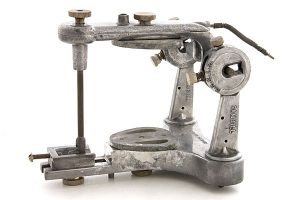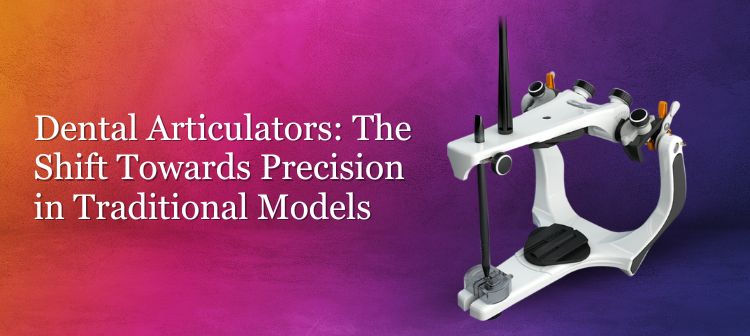Dental Articulators: The Shift Towards Precision in Traditional Models
Dental Articulators: Mastering the Art of Precision
Traditional dental articulators are vital instruments in the art and science of dentistry, helping to create precise dental prosthesis. These indispensable tools for dental offices and labs have been a vital part of the discipline for many years, bridging the knowledge gap between theory and practice. As we go deeper into these vintage instruments, it’s critical to acknowledge their continued significance and the accuracy with which they enhance dental operations.
Traditional dental articulators have a history of fine craftsmanship and in-depth knowledge of dental anatomy. Even with the introduction of digital technologies, these conventional instruments are still quite important in contemporary dentistry. They provide a concrete, hands-on method for comprehending jaw movement, occlusion, and the complex interactions that exist within the oral cavity. In order to create prosthetics that precisely replicate normal oral function and to gain a comprehensive understanding of dental structures, this tactile sense is essential.
This blog explores the history of conventional dental articulators, following their progression from basic mechanical models to increasingly intricate designs. We examine how improvements in engineering and materials science have improved these articulators’ accuracy and usefulness, meeting the increasing need for dental prosthesis to be as accurate as possible.
Through our exploration of the realm of conventional dental articulation, we shall discover the ongoing significance of these instruments in contemporary dentistry. We go over their function in different dental specialties, how they improve prosthetic accuracy, and why they are still an essential component of dental practice and education. This investigation celebrates the harmony between history and innovation in dentistry in addition to taking a retrospective look.

- The Evolution of Traditional Dental Articulators
A Journey Through Time: The History of Dental Articulators
Traditional dental articulators have an interesting history that illustrates the development of dentistry as a whole. Dental articulators were initially crude tools used mainly to mimic the fundamental motions of the jaw. These early versions frequently had basic hinge mechanisms that only offered a small range of motion and adjustability. They did not have the sophistication required for precision dental work, but they did offer a fundamental grasp of occlusal relationships.
Dental articulators became more complicated and functional as dentistry progressed. In the late 19th and early 20th centuries, articulator technology advanced significantly. From simple mechanical tools, articulators have developed into more sophisticated instruments that can replicate the intricate movements of the human jaw. Around this time, adjustable articulators were developed, enabling dentists to more precisely mimic a variety of jaw movements, such as lateral and protrusive motions.
Enhancing Precision with Design and Material Innovations
The development of dental articulators is a tale of both material innovation and mechanical progress. Older articulators lacked precision and durability since they were constructed of simple metals. But just as materials science advanced, so did the design and manufacture of these articulators. More robust and accurate articulators were produced as a result of the use of lighter alloys and stronger, more resilient materials like stainless steel.
The precision of dental prosthesis was significantly improved by these design and material advancements. Dental restorations and appliances can be created with a higher degree of accuracy thanks to the more exact depiction of the patient’s occlusal relationship that modern conventional articulators offer. Because these articulators may be adjusted and fine-tuned, dental prosthesis can be customized more precisely to meet the unique demands of each patient, resulting in a more comfortable fit.
Additionally, more intricate dental procedures can now be carried out with increased accuracy thanks to developments in articulator design. This includes difficult dental procedures like restorative and reconstructive dentistry, where exact prosthetic fit and alignment are essential.

- The Role of Articulators in Modern Dentistry
Sustaining Relevance in the Digital Age
In an era where digital technology is rapidly transforming dental practices, the traditional dental articulator continues to hold a place of importance. Despite the advent of advanced digital tools, the fundamental principles and tactile feedback provided by traditional articulators remain invaluable in contemporary dental practices.
Applications in Modern Dental Procedures
The application of traditional dental articulators extends across various facets of dentistry. In prosthodontics, they are indispensable for creating precise dental prostheses, such as crowns, bridges, and dentures. By accurately mimicking the patient’s jaw movements, these articulators ensure that prostheses are not only aesthetically pleasing but also functional and comfortable for the patient.
In orthodontics, traditional articulators aid in planning and executing complex treatments. They help in understanding the occlusal relationships and jaw dynamics, which is crucial in designing effective orthodontic appliances. Similarly, in restorative dentistry, articulators play a vital role in the reconstruction and rehabilitation of occlusal surfaces, ensuring that restorations are in harmony with the patient’s bite and jaw movements.
Benefits in Dental Treatments
The benefits of using traditional articulators in dental procedures are multifaceted. Firstly, they provide a high level of precision. The ability to adjust and simulate various jaw movements allows dentists to create restorations that align perfectly with the patient’s natural bite, reducing the risk of discomfort or complications.
Moreover, traditional articulators offer a tangible, hands-on approach to understanding dental occlusion. This is particularly beneficial for educational purposes, allowing dental students and practitioners to develop a deep understanding of the complexities of jaw movements and occlusal relationships.
Traditional articulators also facilitate effective communication between dental professionals and laboratories. The physical models created using these articulators can be easily shared and understood, ensuring that the final prosthetics are crafted to the exact specifications required.
- Precision and Accuracy with Traditional Articulators
The Bedrock of Quality Dental Prosthetics
Precision and accuracy are paramount in the creation of dental prosthetics, and traditional dental articulators, such as the Bioart A7 Plus, are at the heart of achieving this high standard. The efficacy of any dental prosthetic, whether it’s a crown, bridge, or denture, hinges on its fit and function, aspects that are directly influenced by the precision of the articulator used in its creation.
Contributions of Traditional Articulators to Dental Precision
Traditional dental articulators, like the Bioart A7 Plus, offer unmatched precision in replicating the patient’s jaw movements. This precision is crucial for ensuring that dental prosthetics not only fit comfortably in the patient’s mouth but also function seamlessly with their natural bite. The Bioart A7 Plus, with its advanced features, allows for meticulous adjustments and simulations of mandibular movements. This level of detail ensures that the prosthetic work is not only aesthetically pleasing but also functionally efficient, reducing the risk of complications such as bite misalignment or discomfort.
Mastering Articulator Techniques for Optimal Results
Effectively using traditional articulators like the Bioart A7 Plus requires a blend of technical knowledge and skilled craftsmanship. Dental professionals must understand the intricacies of jaw movements and occlusal relationships to set up and use these articulators effectively. This involves accurately mounting dental casts, adjusting the articulator to mimic patient-specific movements, and interpreting the data to create precise dental restorations.
The Bioart A7 Plus articulator facilitates this process with its user-friendly design and accurate calibration capabilities. Its ability to mimic a wide range of jaw movements makes it an invaluable tool in creating dental prosthetics that are tailored to the individual needs of patients. By mastering the use of such articulators, dental professionals can ensure that each prosthetic they create is not just a generic product, but a personalized solution that enhances the patient’s oral health and quality of life.

- Challenges and Innovations in Traditional Articulation
Navigating the Challenges of Traditional Articulation
While traditional dental articulators, such as the Bioart A7 Plus, are fundamental in creating precise dental prosthetics, they come with their own set of challenges. One of the primary challenges is the learning curve associated with mastering these devices. Traditional articulators require a deep understanding of dental occlusion and jaw dynamics, which can be complex and time-consuming to acquire.
Another challenge is the manual nature of these tools. Unlike digital systems, traditional articulators rely heavily on the skill and experience of the dental professional. This dependency can sometimes lead to variability in the outcomes, especially in complex dental cases where minute details are crucial.
Adaptation and Skill Development
To overcome these challenges, dental professionals have focused on enhancing their skills and knowledge. Continuous education and training in dental occlusion and the use of articulators are essential. Workshops, seminars, and hands-on training sessions have become integral parts of dental education, helping professionals to stay adept at using these traditional tools effectively.
Furthermore, dental professionals have adapted by combining the use of traditional articulators with other diagnostic tools. For instance, using study models or preliminary impressions alongside articulators can help in achieving a more comprehensive understanding of the patient’s dental anatomy and occlusion.
Recent Innovations in Traditional Articulator Technology
Recent innovations in traditional articulator technology have also played a significant role in addressing these challenges. Manufacturers have focused on enhancing the usability and precision of these devices. For example, improvements in the design and materials used in articulators have made them more durable and accurate. Innovations like adjustable settings for various jaw movements, and more user-friendly interfaces, have made these tools more accessible to a wider range of dental professionals.
Another significant innovation is the incorporation of more detailed calibration systems within traditional articulators. These systems allow for more accurate simulations of individual patient’s occlusal conditions, thereby improving the customization of dental prosthetics.
- Conclusion
Honoring the Legacy of Traditional Articulators in Modern Dentistry
As we conclude our exploration of traditional dental articulators, it’s evident that these time-honored tools hold an enduring significance in the field of dentistry. Despite the rapid advancement of digital technologies, traditional articulators continue to be a cornerstone in the creation of precise and accurate dental prosthetics. Their role in shaping the quality and effectiveness of dental treatments is a testament to the lasting importance of foundational dental tools and techniques.
The Symbiosis of Tradition and Innovation
The journey of traditional dental articulators, from their early inception to the modern Bioart A7 Plus and similar models, reflects a remarkable balance between tradition and innovation. While these devices have evolved in design and functionality, their core principle — accurately replicating human jaw movement — remains unchanged. This enduring principle is what makes traditional articulators an indispensable part of dental practice, even in an era dominated by digital solutions.
The continued relevance of traditional articulators in dental education and practice highlights the importance of tactile experience and hands-on skills in dentistry. The ability to physically manipulate these tools provides invaluable insights into the complexities of dental occlusion and prosthetic design, insights that are as crucial today as they were decades ago.
Furthermore, the integration of new technologies and materials into traditional articulators symbolizes the dental profession’s commitment to blending the best of the past with the innovations of the present. This harmonious integration ensures that dental practitioners are equipped with the most effective tools to deliver high-quality care to their patients.





Leave a comment